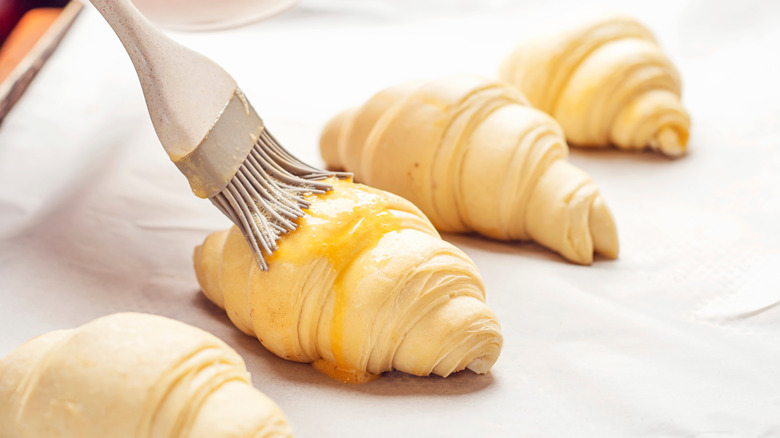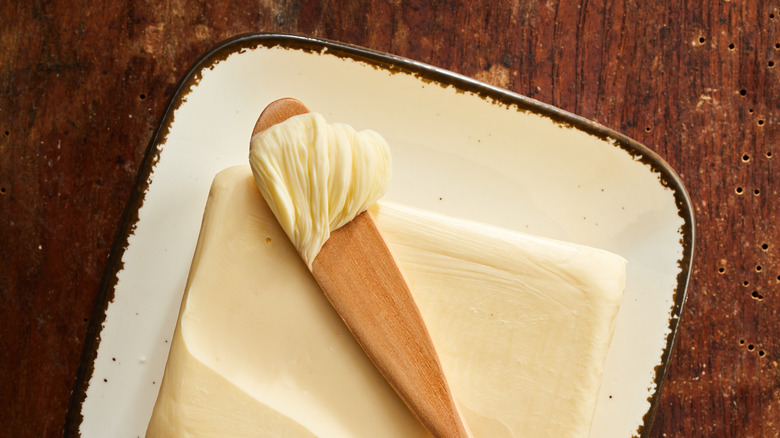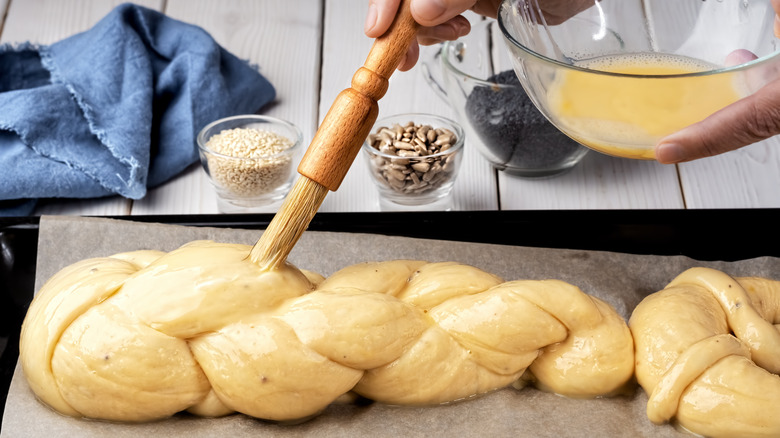Why You Should Almost Always Use Unsalted Butter For Baking
Butter makes the world go around, or at least that's how it feels when we're cooking or baking up a storm in the kitchen. Imagine biting into a corn on the cob without butter. Makes you shudder to even think about it, right? In fact, about a third of the world's milk production is devoted to making butter, per Britannica. People can't get enough.
For such a culinary gamechanger, butter is an almost unbelievably simple ingredient. Butter is made by separating cream from milk. The topmost layer of milk is skimmed away before homogenization, per MasterClass; this layer contains milk's fat content, called butterfat, and it's the primary ingredient in butter. According to Healthline, butter is about 80% fat, and the rest is mostly water. Churning the cream separates the fat globules from the buttermilk, says WebMD, which results in two separate parts: solid butter and liquid buttermilk.
However, there's one small but crucial addition to most butter in the grocery aisle: salt. Salt determines the flavor, freshness, and texture of butter, and, by extension, of the baked goods you make with it. That's why, when it comes to baking, unsalted butter is your new best friend.
Unsalted butter is consistent and fresher
Different butter brands add different amounts of salt to their butter. Olivio brand butter, for instance, has 90 milligrams of sodium per 14 gram (one tablespoon) serving. Meanwhile, Country Crock has 100mg sodium per 14 gram serving. Those 10 grams can make a big difference in your delicate pastries, cookies, cakes, and more.
Household butter name Land O'Lakes recommends using unsalted butter for baking in order to have complete control of the overall flavor of your recipe. This becomes especially important, it says, in baked goods like pound cake or butter cookies, where the sweet cream flavor of butter is the hallmark taste of the final bake. Unsalted butter provides an even, predictable base level on which to build your flavors; it's consistent every time. In this way, you don't have to worry that your baked goods will be too salty or that the balance of saltiness and sweetness will be altered.
Unsalted butter also tends to be fresher than salted butter. Salt is a preservative, explains pastry instructor Joy the Baker, so salted butter has a longer shelf life than unsalted butter. Plus, she says, salt can mask flavors and smells; added salt makes it more difficult to identify when butter has passed its expiration date. According to Spoon University, most refrigerated butters last for six to nine months, or at least one month beyond the printed "best by" date. If you're having a hard time remembering the last time you bought that last stick in the fridge, give it a good sniff.
Salted butter can mess up pastry texture
Perhaps the most surprising advantage of using unsalted butter is that it provides a better texture for baked goods when compared to its salted counterparts. Salted butter contains more water, around 10 to 18% depending on the brand, per Martha Stewart. According to grain purveyor Bob's Red Mill, lower water content is preferable for baking because excess water can prevent the chemical processes gluten requires to form. Since gluten is responsible for the texture and crumb of your baked goods, correct water content is hugely important to a successful finished product.
If you're in a pinch and only have salted butter on hand, don't rush off to the supermarket just yet. The cookie giant Mrs. Fields offers a simple conversion solution. For every 1/2 cup (one stick) of butter called for in the recipe, it says, decrease the amount of salt you add by ¼ teaspoon. The salted butter will fill in the rest.
If your baked goods recipe doesn't specify which type of butter to use, the default is always unsalted, per Food Network. Now that you know how to properly bake with butter, you must simply choose whether you want to purchase one of the fancy butter brands or stick with the more affordable options.


